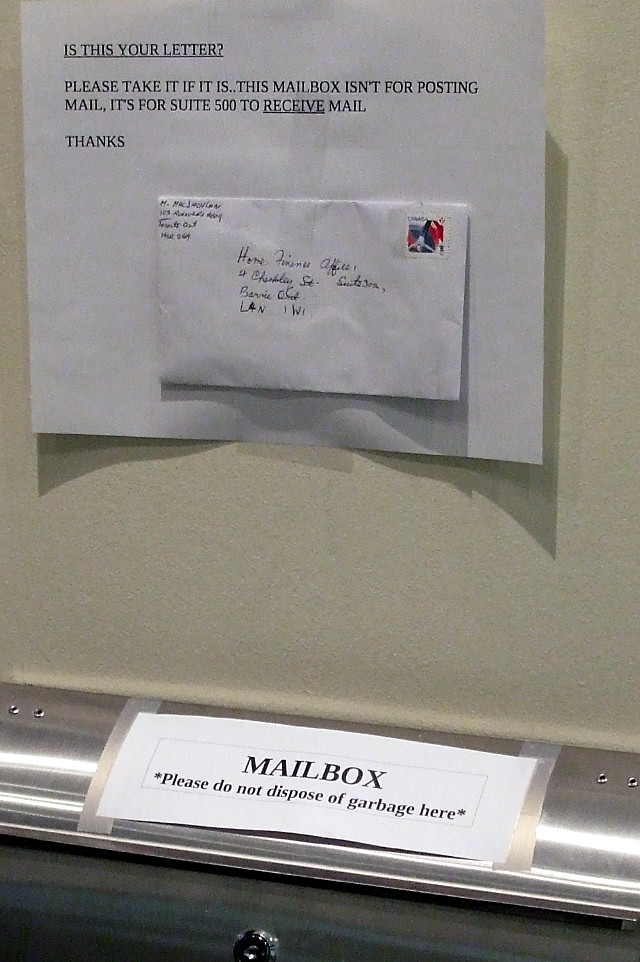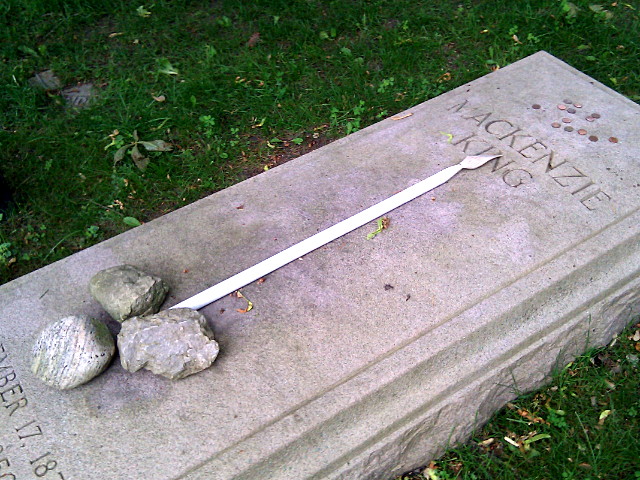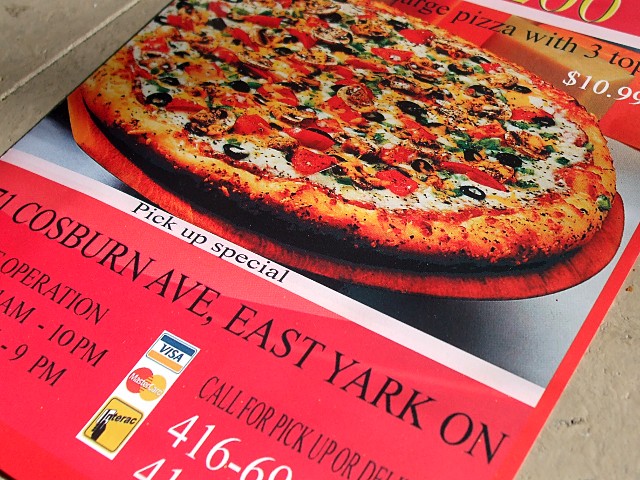Call me what you will, but I don’t think that expecting properly spelled food labels in the local Sobeys is asking for too much. Everybody makes mistakes (guilty!), but is it really possible that no employees or managers noticed this label all day long yesterday? Or is it more likely that the staff noticed but just didn’t care enough to fix it? Either way, it doesn’t exactly give me confidence that Sobeys treats my food with any greater care than, say, the local Loblaws.
Category: wonderings
The problem with modern design and ambiguous instructions
Much of modern design is sleek and minimalist. Unfortunately, some items are designed to be so sleek that their actual function isn’t always readily discernible. Such was the case with the office mailbox below, located directly across from the building elevator. After receiving one too many gum wrappers and coffee cups in the mail, someone taped up a notice describing the purpose of the sleek little box:
MAILBOX
*Please do not dispose of garbage here*
I frequently say that if a simple everyday object like a mailbox or garbage can requires instructions or explanations, it’s a failed design. Even well-meaning instructions can cause confusion. But all seemed well and good until another note appeared a month later, clarifying what the original note meant by “mailbox”:
And later that day, the grateful sender retrieved the wayward piece of mail and left a thank-you note:
Only in Toronto.
A more direct message for drivers
I’m sure you’ve heard about the collision with a truck that killed cyclist Jenna Morrison on Monday. There will be a memorial ride on Monday and a ghost bike will be placed at the intersection where she was killed. A ghost bike both memorializes the cyclist and serves as a reminder to all of what was almost certainly a needless tragedy. There’s already a different kind of memorial at the site of the collision.
Beyond ghost bikes and guerrilla bike lane painting, I think that a less subtle message to drivers is needed wherever a cyclist or pedestrian (or, indeed, a car driver or passenger) is needlessly killed. A ghost bike can be moving if you know what it means, but how many drivers really understand or respect the message? Few, I’d guess. And the ones who do get the message aren’t the ones who need to get it. Which brings me to the photo at the top of this post:
8-28-00 Man 58 Killed here by traffic.
Stencilled with the outline of a body on the street corner where, well, a 58-year-old man was killed by traffic on August 28, 2000. How’s that for direct? When I saw this stencil in San Francisco in September, 2000, you can bet that I paid attention. That I took a picture and knew exactly where to find it in my film archives more than 11 years later should speak to the effectiveness of the blunt message.
The story behind these stencils is told in Jeff Ferrell’s Tearing Down the Streets: Adventures in Urban Anarchy:
Outraged about the way in which “automobiles seem to have taken over the streets and society,” [Ken] Kelton travels the streets of San Francisco, map in hand, searching for sites at which pedestrians have been killed by automobiles. Once a site is located, Kelton lays a life-sized body stencil on the pavement, outlines it with white spraypaint, and writes an asphalt epitaph: “5-15-99 Nameless Man Killed Here By Traffic”; “4-15-99 Woman 71 Killed Here by Traffic.” Though police officials confirm that Kelton risks citation for public vandalism, he continues to consecrate city streets because, as he says, “there’s something wrong with the whole traffic layout, the whole system.”
[…]
A pedestrian death “doesn’t seem to matter. It doesn’t even make the paper,” he says. “I’m trying to underscore that this is life and death.”
Here’s a picture of Kelton with his stencil. Although his crusade was specifically about pedestrian deaths, that article says that he was inspired by a similar activist in New York who memorialized cyclists who were killed in traffic.
The contrast between a ghost bike and a “killed here by traffic” stencil is notable: a ghost bike abstractly represents mourning, while Kelton’s stencil is a more direct declaration that enough is enough. At some point, cyclists, drivers, pedestrians, and—most importantly—our elected leaders have to stop accepting the status quo and say “enough is enough.” That would require taking the safety needs of all road users seriously.
Would having stencils like this dotting city streets cause drivers to be more careful? Maybe not. But it would at least make everyone a little more aware of the human cost of our modern transportation system instead of merely sweeping the statistics under the “it was just an accident” carpet.
Now close your eyes and imagine passing five of these on your way to work every day, whatever mode of transportation you choose. Would it change anything that you do?
This is your turd and final warning (part 2)
You know I love signs. Many of the best ones express one person’s frustration at something that’s beyond his or her control. More often than you’d think, this relates to another person’s (or dog’s) bodily functions. I get such perverse pleasure when I walk into a new (to me) public washroom and see a sign like this. I can’t help but wonder how long and often the sign-writer has had to put up with the problem before going back to his desk, selecting a 44-point font in Word, printing out a shaming notice, and taping it up outside the stalls. But I’m even more curious about whether shaming notices actually work. Anecdotal evidence would say that they don’t, but I can’t tell you how many times I’ve wanted to track down the person who made one of these signs and ask if it generated a concrete result beyond the short-term satisfaction of calling someone out for anti-social behaviour.
Mackenzie King generates some political capital
I rode or walked past William Lyon Mackenzie King‘s grave in Mount Pleasant Cemetery almost every day for three years until last month. Like most graves, not much changed from day to day. Other than a fresh floral arrangement placed on or near the ledger stone every week or two, it was pretty much the same all the time. This colourful yet reliably mundane official tribute got some company this spring when someone placed three rocks on the ledger. And then in early June, a wooden dowel carved into a candle flame and eight (and then thirteen) pennies appeared:
More coins were added to the pot over the next couple of weeks, until on June 27, someone decided to turn the carved dowel and rocks into a slightly more obvious phallic symbol:
East Yark's favarite pizza shap
I can’t help but channel my best Fargo accent whenever I read the location on this pizzeria’s flyer.
As funny a mistake as that is (and as much fun as it is to say “East Yark” over and over and over again), the sad part is that an earnest businessperson is probably losing a significant chunk of potential business from people who think that if you can’t take the time to spell-check the name of your neighbourhood, you can’t be putting much care or attention into cooking pizzas either.
My mother mused for a while about starting a side business doing nothing but quick proofreading of flyers and brochures for local businesses before they get printed and distributed with howlers of mistakes on them. For a few bucks, she’d make any necessary corrections before releasing the work to the printer. She got started by correcting flyers that she received and sending them back to the offending business along with a business card and a brochure of her own. She eventually gave up after getting no responses and continuing to receive misspelled flyers months after she sent in her free corrections. But there must be a viable business in here somewhere, even if only for a printer who looks at the client’s copy and says, “Hey, wait a sec…” instead of just shrugging and starting the press.
Don’t let them tell you it can’t be done.
This is how I remember Jack Layton, from the 2010 East York Canada Day Parade. Risa and I were riding in the parade along with the rest of Ward 29 Bikes and Jack Layton was walking right behind us greeting spectators with a genuine smile and fistful of flags. It was only a few months after he’d revealed his battle against prostate cancer and everyone was happy to see him in such good spirits, even if he looked a touch haggard. I had a brief conversation with him as we made our way at parade pace down Coxwell; 29 Bikes member Vincent, above, spoke with him longer. Even though I’m sure he’d never heard of us before seeing a gaggle of blue t-shirts in front of him, he thanked us for doing cycling advocacy work in the riding. He even apologized for not being able to ride his bike in the parade that year. It was hardly necessary.
To say that I’m a cycling advocate because of Jack Layton is overstating the case a little bit. It’s more that I’m able to be a cycling advocate thanks to Jack; by having a major hand in Toronto’s first tentative steps toward embracing cycling as a form of transportation, Jack certainly made it easier for people like me and the rest of the members of 29 Bikes to come along and take up the cause. A lot of the hard work has already been done, and I’m just trying to see it through.
Don’t let them tell you it can’t be done. That’s a tall order for someone in the cycling advocacy business in Toronto, where “it can’t be done” is the standard official response to just about everything. But if I learned anything from Jack, it’s that progress requires perseverance.
Thanks for everything, Jack.
This is your turd and final warning
You’ve got to admire the homeowner who believes that non-poop-and-scoopers will be cured by a bit of passive-aggressive public humiliation. You’ve got to admire the homeowner who presents a wayward bag of poop to the perpetrator for removal. You’ve got to admire the homeowner who concludes his turd-removal directive with an anticipatory “thank you.” But most of all, you’ve got to admire a homeowner whose style, persistence, and faith in dog-walking humanity hasn’t changed in the three years since I first saw a bag of dog poop nailed to this fence:
If I knew then what I know now…
…I would have taken a picture of Rob Ford campaigning at the East York Canada Day Parade last year, where he was glad-handing the crowd instead of kicking back at the family cottage where he says he’s spent Canada Day for the last 30 years.
Granted, he could have gone up to the cottage after the parade, but his claim that July 1 is some sort of inviolable family cottage getaway is pretty tenuous.
Just one more licence plate
After posting the results of my licence plate hunt last autumn, I vowed never to take or post a picture of another licence plate again. And I’ve let some real doozies pass by undocumented in the ensuing months, never succumbing to the impulse to point the camera at the back of a car. But I just couldn’t resist this meta beauty I saw in a parking lot this morning: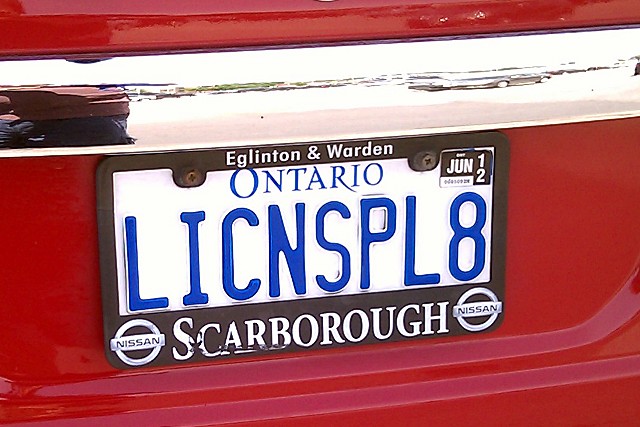
There’s a whole class of personalized plates that I’ve never really understood: the ones that reference the car itself. MY BMW, JIMS JAG, and so on. I mean, I can tell by looking at the car that it’s a BMW or whatever and I’m really not sure why someone needs to use a licence plate as an additional nameplate. One they pay extra for, no less. This one takes needless self-reference and turns it up to 11. I love it.
